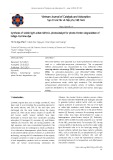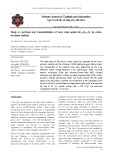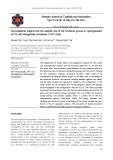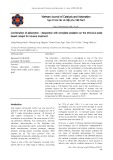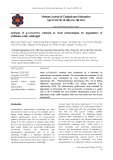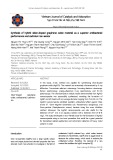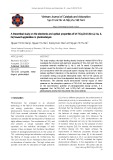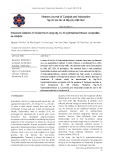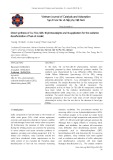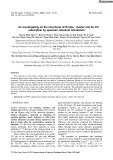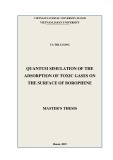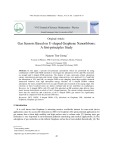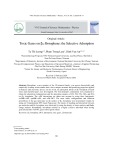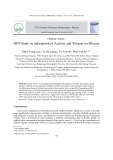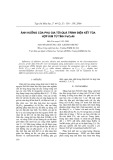
Adsorption energy
-
The results showed that GdFeO3 photocatalyst had a good performance under visible light irradiation. The remarkable enhancement photo-Fenton catalytic activity of GdFeO3 material could be attributed to its small particle size and narrow band gap energy.
 6p
6p  vikwong
vikwong
 29-09-2024
29-09-2024
 2
2
 1
1
 Download
Download
-
The single phase of Mn0.5Fe2.5O4 spinel crystals was prepared by the microemulsion method with the oil phase is DGDE (diethylene glycol diethyl ether). The characteristics of the materials have been determined by the X-ray diffraction (XRD), Energy-dispersive X-ray spectroscopy (EDX), Scanning electron microscopy (SEM) and Brunaure-Emmet-Teller (BET) nitrogen adsorption and desorption, Vibration sampling magnetometer (VSM), Fourier transform infrared spectroscopy (FTIR).
 7p
7p  vikwong
vikwong
 29-09-2024
29-09-2024
 4
4
 1
1
 Download
Download
-
The replacement of noble metals in homogeneous catalysts for the current CO2 hydrogenation reaction with 3D transition metals (Fe, Co, Ni and Mn), with lower costs, have attracted a great attention of many research groups to the interconversion of chemical and electrical energy, like CO2 and H2.
 5p
5p  vikwong
vikwong
 29-09-2024
29-09-2024
 3
3
 2
2
 Download
Download
-
The Adsorption – desorption is considered as one of the most promising VOCs treatment technologies due to its cheap operational cost and low energy consumption. However, there are a huge amount of adsorbed VOCs released in desorption process. That is the reason why this study focused on the combination of adsorption-desorption with catalytic oxidation to treat completely VOCs as toluene.
 6p
6p  vikwong
vikwong
 29-09-2024
29-09-2024
 3
3
 1
1
 Download
Download
-
Novel g-C3N4/InVO4 materials were synthesized by a fabricated via hydrothermal and heating methods. The physicochemical properties of the photocatalysts were investigated by X-ray diffraction (XRD), infrared spectroscopy (IR), Photoluminescence spectroscopy (PL), UV-Vis diffuse reflectance spectroscopy (UV-Vis-DRS) and Energy dispersive X-ray spectroscopy (EDX).
 5p
5p  vikwong
vikwong
 29-09-2024
29-09-2024
 5
5
 1
1
 Download
Download
-
This article reported the preparation of Nano CeO2 by acid method from Binh Dinh monazite ore. Obtained CeO2 was examined by the method of X-ray diffraction (XRD), scanning electron microscopy (SEM) and transmission electron microscopy (TEM), energy-dispersive X-ray spectroscopy (EDS), specific surface area analysis by Brunauer-Emmet-Teller (BET) method, UVVIS.
 5p
5p  vikwong
vikwong
 29-09-2024
29-09-2024
 2
2
 1
1
 Download
Download
-
In this study, in-situ method was applied for synthesizing silver-doped graphene oxide (Ag/GO). The material was extensively characterized by X-ray diffraction, Transmission electron microscopy, Scanning electron microscope, Raman spectroscopy, energy-dispersive X-ray spectroscopy, and UV-Vis spectroscopy.
 6p
6p  vikwong
vikwong
 29-09-2024
29-09-2024
 4
4
 1
1
 Download
Download
-
WO3/Ag3VO4 photocatalyst was synthesized for benefiting the visible region of solar spectrum for degradation of antibiotic pollutant. The prepared catalyst was characterized by using scanning electron microscope (SEM), X-ray diffraction (XRD), infrared spectroscopy (IR) and energy-dispersive X-ray spectroscopy (EDX).
 6p
6p  vikwong
vikwong
 29-09-2024
29-09-2024
 3
3
 1
1
 Download
Download
-
This study employs the tight-binding density functional method GFN1-xTB to investigate the structural and electronic properties of TiO2-ZnO and TiO2-ZnO composite materials modified by Li, Na, K, and Fe metals. Computational analyses reveal the formation of weak covalent bonds between the TiO2 and ZnO components within the composite system. Doping TiO2-ZnO with metals induces significant alterations in the electronic structure, particularly in terms of ionization energy and global electrophilic index.
 5p
5p  vikwong
vikwong
 29-09-2024
29-09-2024
 2
2
 1
1
 Download
Download
-
A series of Mg-Cu-Al hydrotalcite/chitosan materials have been synthesized via a co-precipitation method, in which chitosan is synthesized from chitin extraction from waste shrimp shells. The obtained solids were characterized by XRD, BET, EDX, IR techniques. The materials have a well crystallized hydrotalcite structure and medium surface area.
 5p
5p  vikwong
vikwong
 29-09-2024
29-09-2024
 3
3
 1
1
 Download
Download
-
In this study, the Cu-TiO2-SBA-16 photocatalytic materials were successfully prepared by direct hydrothermal synthesis method. The products were characterized by X-ray diffraction (XRD), Ultraviolet– Visible Diffuse Reflectance Spectroscopy (UV-Vis DRS), energy dispersive X-ray (EDX), transmission electron microscopy (TEM), N2 adsorption–desorption isotherms, X-ray photoelectron spectroscopy (XPS) methods.
 6p
6p  vikwong
vikwong
 29-09-2024
29-09-2024
 3
3
 1
1
 Download
Download
-
Phase change materials have excellent thermal energy storage capacity, making them an appealing option for energy management applications. Stabilizing the form of phase change materials enhances their practical effectiveness. This research focuses on sustaining the shape of low molecular weight PEG phase change materials in wood structures made from natural balsa wood.
 6p
6p  vikwong
vikwong
 29-09-2024
29-09-2024
 1
1
 1
1
 Download
Download
-
This global minimum structure has the shape of a tetragonal bipyramid having two Sc atoms at two tops of pyramids binding with one edge of Ge-Ge. The ground electronic state of the global minimum isomer is the 2B2 state in the C2v symmetry. The most stable isomer of Sc2Ge6 − has been used to study the CO adsorption. The calculated results indicate that the Sc2Ge6 − cluster has a good interaction with the CO molecule. The adsorption positions are around the Sc atom with two stable models include adsorbing the C atom and adsorbing both the C and O atoms of the CO molecule.
 7p
7p  dianmotminh02
dianmotminh02
 03-05-2024
03-05-2024
 4
4
 2
2
 Download
Download
-
In this study, the adsorption configuration, adsorption energy of toxic gas molecules (CO, NO, CO2, NH3, and NO2) on B12 – borophene was investigated by first – principle calculations using three van der Waals correlation functionals: RevPBE-vdW, optPBE-vdW, and vdW-DF2.
 65p
65p  closefriend03
closefriend03
 13-10-2021
13-10-2021
 24
24
 4
4
 Download
Download
-
In this paper, I present first-principle calculations which are performed by using combination of DFT and NEGF methods to investigate the adsorption of CO2 and NH3 molecules on straight and U-shaped GNRs junctions. The density of state, molecular orbital, adsorption energy, transmission spectrum, and current-voltage characteristics were analyzed.
 8p
8p  tamynhan6
tamynhan6
 14-09-2020
14-09-2020
 32
32
 1
1
 Download
Download
-
In this work, the adsorption ability of β12 borophene towards some main harmful gases was investigated. The first-principles calculations were employed to obtain the adsorption configurations and the adsorption energies of CO, NO, CO2, NH3, and NO2 on 12 borophene. The vdW interactions are taken into account by using three functionals: revPBE-vdW, optPBE-vdW, and vdW-DF2.
 8p
8p  tamynhan6
tamynhan6
 14-09-2020
14-09-2020
 45
45
 5
5
 Download
Download
-
In this work, we investigated the adsorption mechanism of acetone and toluene on the surface of silicene by the quantum simulation method. The images of the potential energy surfaces for different positions of the adsorbate on the silicene surface were explored by Computational DFTbased Nanoscope tool for determination of the most stable configurations and diffusion possibilities.
 8p
8p  tamynhan6
tamynhan6
 14-09-2020
14-09-2020
 24
24
 3
3
 Download
Download
-
Thiol-functionalized SBA-15 silicas have been directly synthesized by cocondensation of tetraethyl orthosilicate (TEOS) and 3-(trimethoxysilyl)-1-propanolthiol (TSPT) under hydrothermal condition. Mesoporous structure was obtained after the surfactant removal by Soxhlet and reflux ethanol extraction. These materials were characterized by means of powder X-ray diffraction, isotherms of nitrogen adsorption/desorption, thermal analysis, infrared spectroscopy and energy-dispersive X-ray spectroscopy.
 9p
9p  thiendiadaodien_9
thiendiadaodien_9
 04-03-2019
04-03-2019
 24
24
 0
0
 Download
Download
-
Influences of additives saccarin, thioure and natrilaurylsulphate on the electrodeposition process of the alloy FeCoNi were investigated using polarization curves and energy disperse spectroscopy (EDS). Results show that saccarin increases the anomalous ratio of the couples Fe/Ni (TFe/Ni) and Co/Ni (TCo/Ni) while thioure influences on TFe/Ni, TCo/Ni slightly and natrilaurylsulphate decreases TFe/Ni, TCo/Ni remarkably. The results can be explained by the different adsorption processes of the additives.
 4p
4p  uocvong02
uocvong02
 24-09-2015
24-09-2015
 24
24
 2
2
 Download
Download
-
Adsorption by activated red mud (ARM) is investigated as a possible alternative to the conventional methods of Cr(VI) removal from aqueous synthetic solutions and industrial effluents. Adsorption characteristics suggest the heterogenous nature of the adsorbent surface sites with respect to the energy of adsorption. Various factors such as pH, contact time, Cr(VI) concentration, amount of adsorbent, and temperature are taken into account, and promising results are obtained.
 0p
0p  tudoia
tudoia
 06-04-2011
06-04-2011
 79
79
 7
7
 Download
Download
CHỦ ĐỀ BẠN MUỐN TÌM









